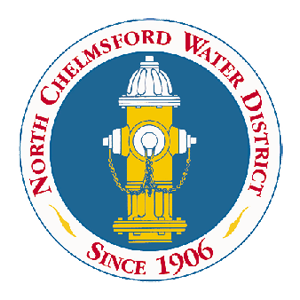Q: What is a “cross-connection”? What is “backflow”?
A: If these terms seem familiar, you’ve probably seen them while reading our annual Consumer Confidence Report! A “cross-connection” is a point in the water system where potable (drinkable) water and a source of contamination meet. “Backflow” refers to the reverse flow of water within the system.
Q: What are some examples of cross-connections?
A: Drinking water entering a chemical mixing station (usually used in cleaning stations), drinking water entering a boiler with glycol (which helps prevent water lines from freezing), a sink nozzle submerged in soapy water, and a hose submerged in a mop bucket a pool. There are many ways in which a cross-connection can be made!
Q: What causes backflow?
A: Simply put, backflow is caused by a change in the system’s water pressure level. “Backsiphonage” occurs when the pressure upstream drops (such as during a main break), and “backpressure” occurs when the upstream pressure exceeds downstream pressure (such as a pump upstream). As you have likely heard, all systems seek “the path of least resistance”, so water under high pressure will always try to flow towards a lower pressure area, even if this means flowing in the opposite direction of normal flow.
Q: So, which one is dangerous? A cross-connection, or backflow?
A: By themselves, neither one is dangerous. The danger is present when there is backflow at a point of cross-connection, meaning that the contaminated water, which is supposed to flow downstream, is reversed to flow upstream, therefore moving through the drinking water system.
Q: How is the North Chelmsford Water District making sure that our water is safe from this contamination?
A: There are a few ways:
- We conduct “cross-connection surveys” across the water system to identify cross-connections
- In collaboration with the Town of Chelmsford Plumbing & Gas Inspector, we enforce state and local regulations to require that “backflow prevention devices” be installed at cross-connections (these devices prevent contaminated water from flowing backwards into the drinking water system)
- We regularly test these devices to make sure they work properly
- Improving community education and communication
Q: What can I do to stop contaminated water from flowing back into the drinking water system?
A: Generally speaking, residential properties do not have as many opportunities for cross-connections since there aren’t as many, if any, chemicals connected to the drinking water system. That being said, there are still a few ways in which you can prevent and protect cross-connections at your residence:
- Never submerge a hose in any substance or leave it in a bucket, sink, etc.
- Install a “hose bibb vacuum breaker” (HBVB), a type of backflow prevention device, on your hose connections (see below)
- If you aren’t sure whether something is a cross-connection, reach out to us! We’re always happy to answer your questions, especially when it helps keep our water safe!
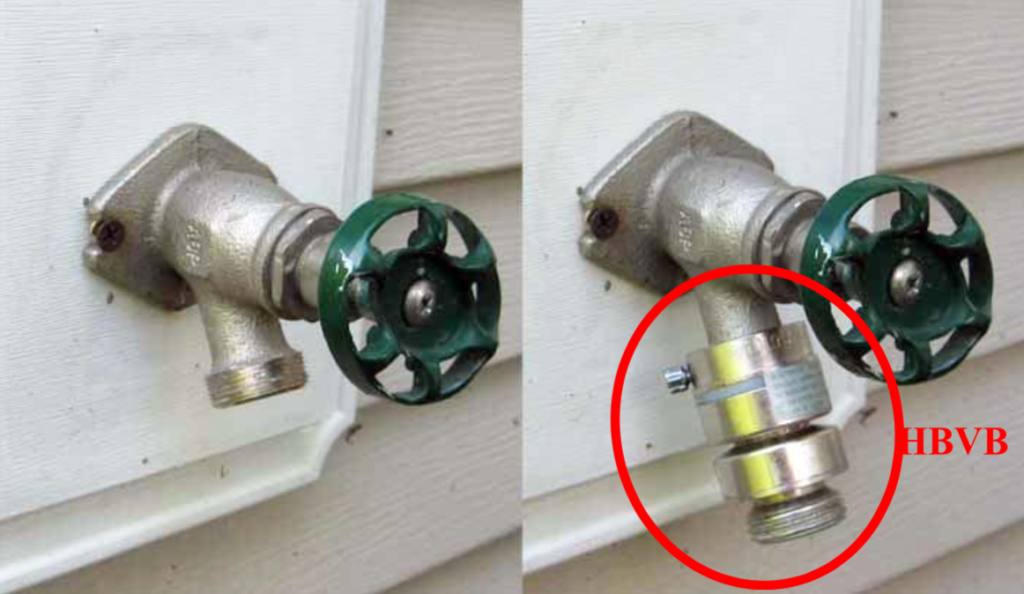
Q: Where can I get an HBVB? How much do they cost?
A: HBVBs are typically available at your local hardware store for less than $15. Please note that these devices do not require a permit or a test due to the nature of their design.
Q: Are there other types of backflow prevention devices?
A: Yes! Backflow prevention devices can be broken down into 2 categories: testable and non-testable. As the names suggest, testable devices must be tested to ensure that the device is functioning properly, while non-testable devices cannot be tested and are recommended for replacement every 5 years (per manufacturer standards). Their designs are different but still provide protection.
Q: What are the different styles of testable backflow prevention devices?
A: Reduced Pressure Backflow Preventors (RPZs), Double Check Valve Assemblies (DCVAs), Pressure Vacuum Breakers (PVBs), and Spill-Resistant Vacuum Breakers (SRVBs). These devices typically aren’t used in most residential applications (if any, it would likely be a PVB for irrigation or an RPZ/DCVA for a fire suppression system).
Q: What are the differences amongst RPZs, DCVAs, PVBs, and SRVBs?
A: Each device is designed differently and therefore approved for different situations. For example, an RPZ is designed to deal with biological contaminants and would be used to isolate a kidney dialysis machine, since it has a discharge vent to completely drain any contaminated water. RPZs and DCVAs have more flexibility with installation, as they can be subject to both backpressure and backsiphonage, whereas PVBs and SRVBs can only be used on systems which are not subject to backpressure.
Q: How should I know what type of device to install?
A: That’s where we come in! Unless you are a plumber or fire sprinkler contractor, we don’t expect you to have extensive knowledge about these devices, so don’t worry! After we conduct a cross-connection survey, we will give you a report detailing the device(s) which need to be installed; you should pass this report onto your plumber or fire sprinkler contractor so that they can resolve the situation. If they have any questions about the report, they should contact us directly so we can provide clarity.
Note: this is why it is so important for your plumber/fire sprinkler contractor to submit a Backflow Prevention Device Design Data Sheet (Permit Application) to us, so that we can make sure the correct device will be installed and avoid delays! This application is available under “For Plumbers/Fire Sprinkler Contractors”.
Q: Testable backflow prevention devices are more expensive than non-testable backflow prevention devices. Why can’t I just use a non-testable one?
A: We are obligated to enforce our governing state code, 310 CMR 22.22. While there is room for some situational discretion, we must comply with the state’s guidelines to maintain the safety and security of the water system. 310 CMR 22.22 is clear regarding which type of device is approved for which purpose, and we are not permitted to override that regulation unless our decision is stricter than the state’s.
Q: Do I need a backflow prevention device right after my water meter?
A: If your property is zoned as “residential” and contains fewer than 3 units, you do not need a device right after your water meter. There is no existing regulation that requires this, and this would be an extra cost to you. If you have any cross-connections present in your system, those should be protected accordingly (like with HBVBs for hose connections).
Q: Where can I get more information about backflow prevention devices?
A: You can reach out to us at northchelmsfordwater@outlook.com, consult 310 CMR 22.22 online, and access our Ordinance at Rules, Regulations, & Rates.
Examples of Backflow Prevention Devices
Please note that the North Chelmsford Water District does not endorse any particular backflow prevention device manufacturer or company by using the images below. These images are simply meant to provide visual examples of these devices in relevant situations.
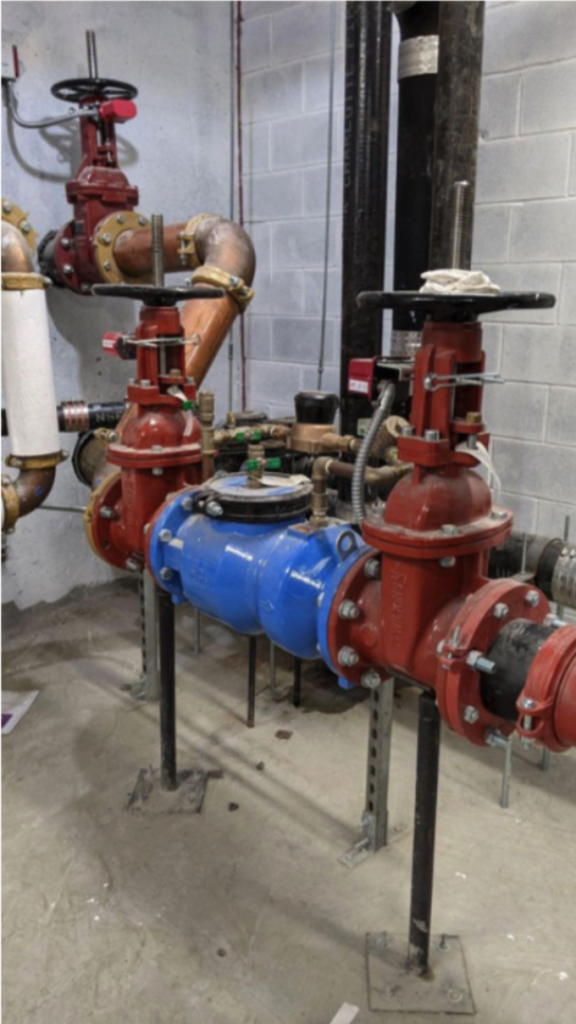
(Credit: Ettinger Engineering Associates)
Figure 1: Fire Suppression System with DCVA
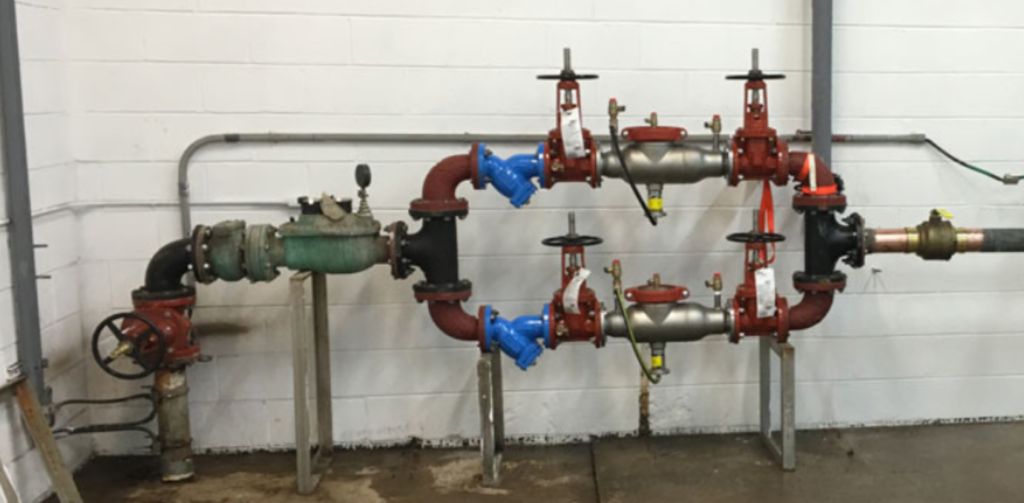
(Credit: Backflow Prevention Journal)
Figure 2: Domestic Water System with RPZ Containment and Bypass
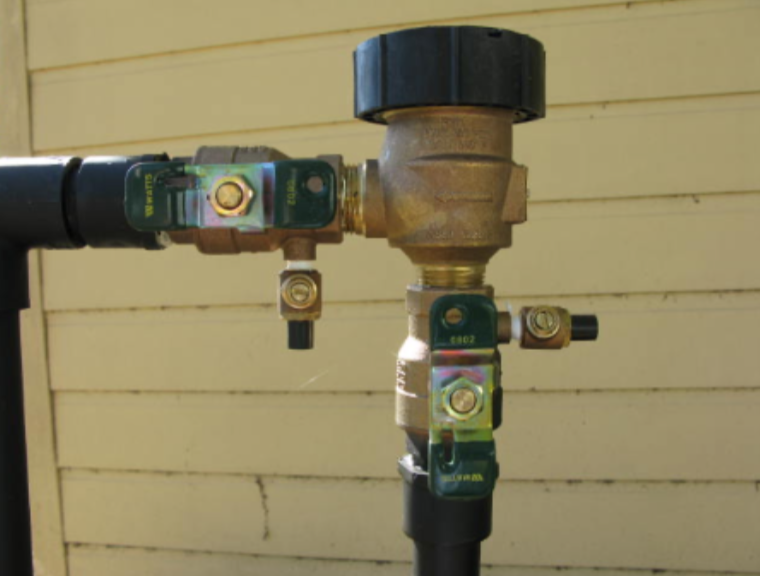
(Credit: Hessenauer Sprinkler Repair & Irrigation)
Figure 3: Irrigation System with PVB
